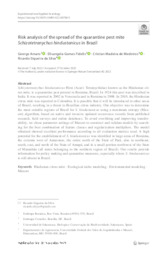Risk analysis of the spread of the quarantine pest mite Schizotetranychus hindustanicus in Brazil.
Risk analysis of the spread of the quarantine pest mite Schizotetranychus hindustanicus in Brazil.
Author(s): AMARO, G. C.; FIDELIS, E. G.; MEDEIROS, C. M.; SILVA, R. S. da
Summary: Schizotetranychus hindustanicus Hirst (Acari: Tetranychidae) known as the Hindustan citrus mite, is a quarantine pest present in Roraima, Brazil. In 1924 this pest was described in India. It was reported in 2002 in Venezuela and in Roraima in 2008. In 2010, the Hindustan citrus mite was reported in Colombia. It is possible that it will be introduced in other areas of Brazil, resulting in a threat to Brazilian citrus industry. Our objective was to determine the most suitable regions of Brazil for S. hindustanicus using a maximum entropy (Max‑ ent) algorithm, based on native and invasive updated occurrence records from published research, field surveys and online databases. To avoid overfitting and improving transfer‑ ability, we chose parameter settings of Maxent to construct and validate models by searching for the best combination of feature classes and regularization multipliers. The model obtained showed excellent performance according to all evaluation metrics used. A high potential for the establishment of S. hindustanicus was identified in large areas of Roraima, the extreme west of Amazonas, the entire north of the State of Pará, also in northeast, south, east, and north of the State of Amapá, and in a small portion northwest of the State of Maranhão (all states belonging to the northern region of Brazil). Our results provide information for policy making and quarantine measures, especially where S. hindustanicus is still absent in Brazil.
Publication year: 2022
Types of publication: Journal article
Unit: Embrapa Roraima
Observation
Some of Embrapa's publications are published as ePub files. To read them, use or download one of the following free software options to your computer or mobile device. Android: Google Play Books; IOS: iBooks; Windows and Linux: Calibre.
Access other publications
Access the Agricultural Research Database (BDPA) to consult Embrapa's full library collection and records.
Visit Embrapa Bookstore to purchase books and other publications sold by Embrapa.

